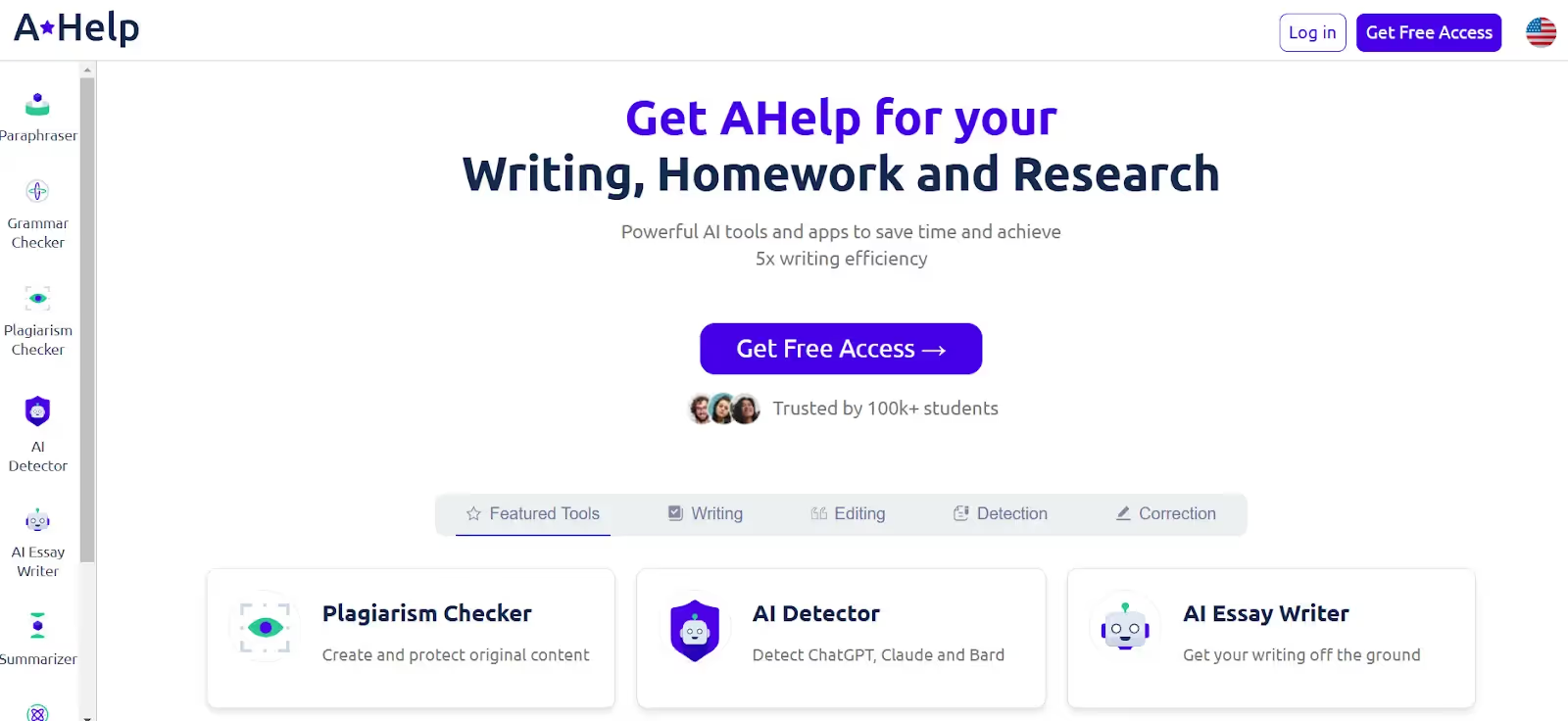
AHelp offers several AI-driven tools including a paraphraser, grammar checker, and plagiarism detector. Its goal is to help provide writing, homework, and research help to college and university students.
For our review, we wanted to see how the AHelp Free Plagiarism Checker compares to the industry-leading Originality.ai Plagiarism Detector; including a brief overview about the platform, and how it handles direct and patchwork plagiarism.
See how the AHelp plagiarism checker performed in four tests with the Originality.ai plagiarism checker in our detailed review below.
AHelp is a free online service that offers access to a variety of AI-driven tools. For the purpose of this review, we tested the AHelp plagiarism detector to see how it compares to the Originality.ai plagiarism checker.
The tools that AHelp offers include: a grammar checker, paraphraser, AI writer, and plagiarism detector. Students use AI-driven services like AHelp to help them check their grammar for academic articles and work, generate citations correctly for proper referencing, and summarize passages for concise writing.
AHelp can also be used to gain inspiration for essay content by working with the multilingual AI writer or via the Google Chrome extension.
Looking for an alternative Chrome extension? Check out Originality.ai’s Chrome Extension with 4 products (an AI Checker, Plagiarism Checker, Readability Checker, and Grammar Checker) in 1 extension.
AHelp is made for students who are looking to leverage AI tools to improve their writing.
From grammar corrections to AI outlines and plagiarism detection, AHelp is designed for those students looking for additional support with writing consistently high-quality copy for essays, and academic papers by:
However, it’s important to note that not all academic institutions or assignments permit the use of AI tools. So, before using an AI tool to support academic work, check with your instructor.
Learn more about AI detection for education.
For this test, although AHelp does offer other tools, we focused exclusively on AHelp’s free plagiarism-checking tool.
We divided the test into two parts:
Step 1: We first took two blog posts from the Originality.ai blog.
Step 2: Next, we pasted the blog content directly into the Originality.ai plagiarism checker and into AHelp’s plagiarism checker and then ran each tool.
We chose text samples directly from the Originality.ai blog:
Step 3: For the second part of the test, we chose examples of patchwork plagiarism. Patchwork plagiarism is a more subtle example of plagiarism, and is often difficult for even modern plagiarism checking tools to catch.
Step 4: We then ran both samples through AHelp and the Originality.ai Plagiarism Checker to compare results.
Originality.ai Plagiarism Checker: 100% Match

AHelp: 92.61% Match

Originality.ai Plagiarism Checker: 100% Match

AHelp: 10.87% Match

Originality.ai Plagiarism Checker: 65% Match

AHelp: 53.65% Match

Originality.ai Plagiarism Checker: 89% Match

AHelp: 25.95% Match

AHelp showed a strong initial performance and was able to spot the majority of matching text from the first published blog (92.61%).
However, from there on, its performance dropped. When it came to testing the second example of a published blog, AHelp’s plagiarism checker only scored slightly above 10%.
In contrast, the Originality.ai Plagiarism Checker identified a 100% Match on both published blogs.
Next came the patchwork plagiarism test.
Here the Ahelp plagiarism checking tool scored a little over 53% on the first example, and 25.95% on the second — both results were below Originality.ai’s plagiarism detection which identified a 65% Match and an 89% Match respectively.
With such scattered results from the Ahelp plagiarism checking tool, it’s clear that there are potential limitations, which may impact the efficacy of detection in a variety of use cases whether reviewing academic or marketing content. So, more testing is needed before selecting it as your checker.
In this test, the Originality.ai Plagiarism Checker scored consistently high marks against both direct copy and paste (of published blogs) as well as patchwork plagiarism samples.
The Originality.ai Plagiarism Checker is built for content professionals and is designed for a high degree of accuracy when it comes to checking both direct copy-and-paste plagiarism and more complex types of plagiarism such as patchwork plagiarism.
Originality.ai’s plagiarism checker also generates a complete report with highlighted instances of potential plagiarism and sources so that editors can verify the matching text or review citations. This lets content professionals quickly make changes to ensure their citations are correct.

AHelp’s plagiarism checker was unable to reliably and consistently detect both verbatim plagiarism and patchwork plagiarism across the tests we ran in this analysis.
This means that if you’re considering using AHelp as a plagiarism-checking tool, you should conduct your own tests and review the results carefully.
For a more reliable plagiarism checker that handles both direct and patchwork plagiarism as well as many other types of plagiarism, consider the Originality.ai plagiarism checker.
Read more plagiarism checker reviews:
AHelp’s plagiarism checker is free to use. Although for the purpose of this test, no limits were in place, the FAQ for the free version does state that limits may be placed on the number of searches to keep the tool freely available to everyone.
There are also basic and premium pricing tiers which enable you to use all of the tools, not just the plagiarism-checking feature. The premium plan allows for unlimited use of the tool for $8.33/month, billed yearly.
It checks academic papers, blog posts, and more for plagiarism with the test typically taking less than a minute to conclude. The resulting report shows what percentage of text matches, but to go beyond basic information, users will need to upgrade to a paid plan.
AHelp’s plagiarism checker lets users check any type of text, including uploading files in Microsoft Word format, plain text and PDF format.
The plagiarism checker works in a variety of languages, making it a helpful tool for those who want to check their work submitted in another language. Currently, the tool can check for plagiarism in English, Spanish, Portuguese, German, French, Italian, and Dutch.
